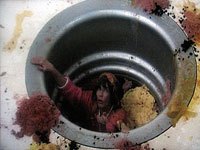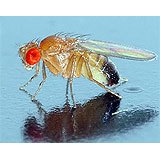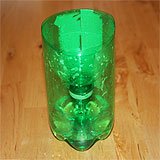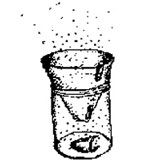
Fruit flies (scientifically speaking Drosophila, usually melanogaster) love large food-like messes, especially old fruits and vegetables. It doesn’t stop there: fruit flies are attracted to, and will lay their eggs in, almost any form of moist decaying organic matter. To make matters worse, they can lay in excess of 500 eggs at a time. While they are a year-round problem, they tend to be worst in late summer and early fall. Here’s how to get rid of them:
Find and remove all food-based breeding grounds.
Start in the kitchen.
- Dispose of any overripe fruits or vegetables.
- Cover fruit bowls or put them in the fridge.
- Do the dishes. Fruit flies will lay eggs on leftover plates and in dirty glasses.
- Search through every cupboard and check for wet or infested foodstuffs,
- Take out the garbage immediately.
- Look under beds and in closets for dirty dishes.
- Wash all sponges, dish rags, and towels.
- Sweep and mop, dump mop water, clean bucket, and wash mop head.
Find and remove all other breeding grounds.

Once you have disposed of all their favorites, fruit flies will be forced to find alternatives. You will need to find and take care of these as well.
- If you have one, start by cleaning the dishwasher.
- Clean all excess food and liquid spots.
- Do dishes by hand until the fruit fly infestation is gone.
- Clean under the stove and under the oven.
- Clean the seals on the fridge and freezer doors. P
- lants and flowers attract fruit flies with their nectar and wet soil, take ’em outside.
- Check to make sure there aren’t leaks under the sinks where wood may be rotten.
- Clean drains and garbage disposals.
- Clean up any lint around the washing machine as it traps moisture.
The good news is that many of these tasks are basic home and kitchen cleanliness habits. Not only will you prevent fruit fly infestations, but these steps will be helpful in getting rid of maggots, houseflies, and other nuisances.
Proper storage measures.
Once you have done everything to remove breeding grounds for fruit flies, focus on appropriate storage. Get some good canisters, cans, or plastic storage containers with tight-fitting lids for food products that might attract fruit flies if it gets damp. You may want to give Rubbermaid modular canisters (here on Amazon) a shot, they stack nice and easy. If you run across something that you’re not sure about, put it in a container. sBe sure to also get a garbage can with a tight-fitting lid.
Block Your House
Stop them from getting in again: if you have trash cans sitting outside, start keeping them as far from the house as possible. Throw yard waste on top of your food compost pile (to prevent more growth), or just stop composting. Patch holes in window screens. Keep doors closed. Fill in any cracks around windows.
Set a 2 Week Alert

Under normal temperature conditions, it could take anywhere from 7 to 14 days for fruit flies to move from egg to adult. So don’t think the fruit flies are gone until at least two weeks have passed. Keep up on sanitation! That will stop any new adults that might emerge from propagating the species. After the two weeks have passed fruit-fly free, you can breathe a sigh of relief. This is roughly the same timeframe you would expect with drain flies and other small flies that resemble the fruit fly.
Fruit Fly Identification

- About 1/8 inch long
- Red eyes
- Tan, brown, yellow or greenish in color
- Often mistaken for drain flies
Commercial Products to Get Rid of Fruit Flies
You can check on Amazon and you’ll find that fruit flies can be killed with a bunch of different stuff. The most common of these is fruit fly traps. Most are plastic or cardboard units filled with sticky stuff and an attractant like vinegar or fruit scent. They can be placed almost anywhere. There are even some electric fruit fly traps that plug into an ordinary outlet like the FlyWeb Fly Light and the Insectalite 30 Watt Professional. These use a little lamp to lure fruit flies in where they get stuck to a glue board. And, of course, you can’t forget about the tried and true fly strips. If you’re looking for something to kill them in flight, there are also numerous pyrethrin sprays available like:
- Clear Zone I Pyrethrin Aerosol
- CB Intruder HPX
- Microcare Aerosol.
If you’re looking for something to dump down the drain to kill fruit flies, I would suggest InVade Bio Drain Gel (found here at Amazon) or DF 5000 Drain Gel.
Best Homemade Fruit Fly Traps
However, you can build your own fruit fly traps that can save you some money, especially similar to those scented ones mentioned previously. Check them out!

Soda bottle fruit fly trap.
Cut the top off a clean two liter soda bottle just above the label and put a couple inches of juice, wine, red wine vinegar, balsamic vinegar, or beer in the bottom. Invert the top of the bottle with the lid off and stuff it down. Seal the edge with some duct tape. The fruit flies go in but can’t get back out.

Funnel fruit fly trap.
Make a cone from a sheet of construction paper and cut the top off to create a funnel. Pour a little cider vinegar in the bottom of a clean jar and, without allowing the bottom to touch the liquid, stick the funnel in the jar so it fits tight. You may need to use some tape to avoid any gaps. The fruit flies are attracted to the cider vinegar, fly into the cone, can’t get out, and drown.

Bowl fruit fly trap.
Put a bowl out that’s full of old fruit, juice, vinegar, or a combo. Cover the bowl tightly with plastic wrap and put a rubber band around it. As an alternative, you can add some dish soap to the apple cider vinegar to break the surface so they drown rather than walk. Stab tiny holes in the cover, that way they can get in. Don’t make the holes too big or the fruit flies will get back out.